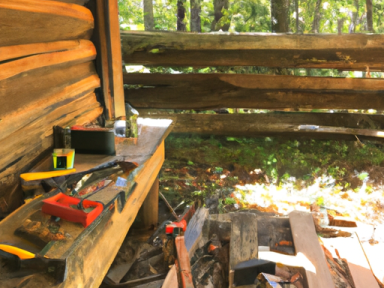Imagine it: you find yourself in the midst of the untamed wilderness. No modern conveniences, no safety net. Just you and the elements. How would you survive? One crucial aspect of survival in the wilderness is building a shelter. In this article, we will explore the methods employed by pioneers to construct their shelters and learn from their resourcefulness and ingenuity.
The Importance of Shelter
In the wild, shelter is your first line of defense against the harsh elements. It provides protection from wind, rain, snow, and extreme temperatures. A well-built shelter keeps you dry, warm, and safe from predators. Without a sturdy shelter, the chances of survival diminish significantly.
Pioneer Shelter Building Techniques
1. Log Cabins
One of the most well-known and enduring pioneer shelter types is the log cabin. Pioneers would choose an area with accessible trees and cut down logs to create the walls. The notched corners of the logs would fit together tightly, providing stability and insulation. The walls were then chinked with mud or clay to seal any gaps and keep out drafts.
2. Sod Houses
In regions where trees were scarce, pioneers turned to the land itself for shelter. Sod houses were constructed using bricks made from blocks of sod, which is a layer of grass and soil held together by the root system. These bricks were layered to form the walls, with beams and a sod roof added for stability. Sod houses provided excellent insulation, keeping out both heat and cold.
3. Dugouts
Dugouts were another common shelter built by pioneers, particularly in areas with scarce building materials. A dugout was essentially a hole dug into the side of a hill or slope. The walls and roof were often reinforced with logs or sod to prevent cave-ins. While not luxurious, dugouts provided protection from the elements.
4. Lean-to Shelters
Lean-to shelters were a quick and simple solution for pioneers on the move. These shelters consisted of a slanted roof supported by a pole or tree trunk, with one end open and the other closed off. The open end faced away from prevailing winds, providing a windbreak and a relatively cozy space to sleep.
Pioneer Ingenuity
What stands out about pioneer shelter building is the resourcefulness and ingenuity of the individuals. They made use of whatever materials were available in their surroundings. They worked with their environment, adapting and finding innovative solutions to survive.
As we reflect on the methods employed by pioneers, we are reminded of the importance of preparedness in our own lives. While we may not find ourselves in the exact same circumstances as the pioneers, learning from their experiences can inspire us to be self-reliant, adaptable, and inventive.
So, take a moment to consider what shelter-building skills you possess. Are you prepared for an unexpected wilderness situation? Do you have the knowledge and tools to construct a shelter from scratch? If not, it’s time to learn. Invest in your survival skills and ensure your readiness for any situation that may come your way.
Remember, the pioneers relied on their own abilities to survive and thrive in the wilderness. You can do the same. Take action now and become proficient in the art of shelter building.




GIPHY App Key not set. Please check settings